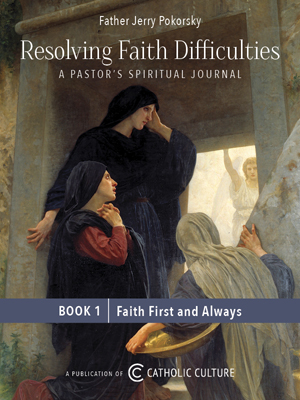Make your gift today!
Help keep Catholics around the world educated and informed.
Already donated? Log in to stop seeing these donation pop-ups.
Catholic Activity: Work and Vocation
Parents should urge children from an early age to pray that they may find their true vocation and carry it out faithfully.
DIRECTIONS
Praying for the grace to know his vocation goes hand in hand with teaching a child to work. We can help children send out vocational feelers by watching for signs of gracefulness and enthusiasm with particular types of work. There is something very intriguing about knowing one has a vocation picked out for him by God, and watching to see it unfold. Little girls will want to be nuns one day, mothers the next, and ballet dancers the next. It is utterly reasonable, then, to include in one's prayers, "Please, Blessed Jesus, help me to know if I am to be a Sister, a mother, or a ballet dancer." And the days when they decide it is "mother" they are supposed to be, it is a handy suggestion to be reminded to ask God for help finding the right "father." Other people have wasted their entire lives trying to find their vocations. It is not too early to begin praying in childhood; and if one's vocation is to be motherhood — then fathers are a most essential part!
Family prayer about vocations helps parents to keep hands off in the matter of following in Father's footsteps, or being a lawyer because "I've always hoped for a son who would be a lawyer." It helps level opposition to the first signs of a religious vocation, or the indication that early marriage is best for this girl or this boy. It helps those who may one day become highly trained professional men and women to respect the more humble occupations of their less gifted brothers and sisters. Doctors, lawyers, scientists, engineers could not do their work, for all their gifts and training, without the men and women who make their instruments, string their telephone wires, raise their food, build their laboratories and offices. And when we remember that Christ chose to be a carpenter, we dare not allow any of our children to cultivate any snobbishness about the unimportance of "workmen."
Perhaps the lesson it takes longest to teach is reverence for work; this is an attitude that comes slowly, with maturity. It is the final ingredient in the making of a good workman. We can begin when the children are little by teaching them to notice the properties of materials, consider their source, think of the intelligence of mind and dexterity of hands that are needed to transform them into beauty and usefulness. As our children watch us work, we can point out these things as symbols of spiritual reality.
For instance, yeast. Yeast is a powerful and mysterious plant, microscopically small yet capable of lifting a mountain of dough. Scald it and it will die. Chill it and it is inactive. Mix it with lukewarm water or milk, with the proper amounts of sugar and salt, fat and flour, knead it rhythmically on a floured board, and it springs to life and is the unifying principle of bread. How like grace, which scalded by passion will die; chilled by indifference will remain inactive; accepted with gratitude and love, used by the heart and mind and will, it will transform souls into more perfect Christians, bearing more effectively their part in the restoring of society to Christ.
A father and son planting a garden work with the symbols of eternal life. Seeds, like self-love, must be buried and seem to die before they will spring to life and bear fruit. Rain, like grace, must water them. The sun, like God's love, must warm them. Weeds, like sin, must be rooted out. This is how Christ taught. The parables He used to teach His followers are under our very noses. Following His example, teaching with our own parables as well, we slowly communicate reverence, and when finally they have learned this, they will be men and women who know it is not a curse, but a blessing, to work.
Activity Source: We and Our Children by Mary Reed Newland, Image Books, 1961






